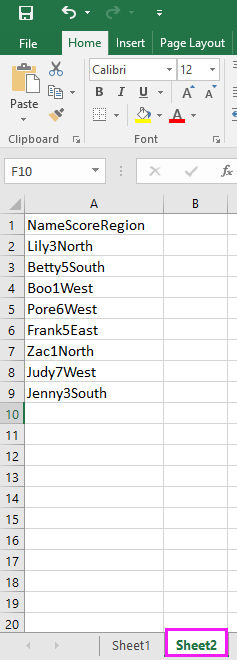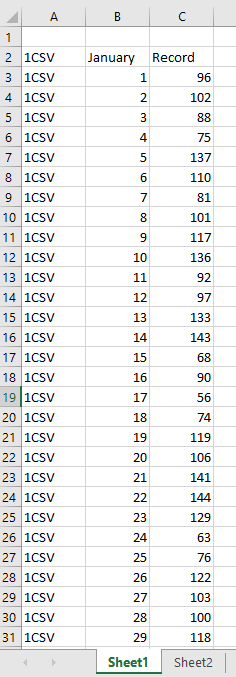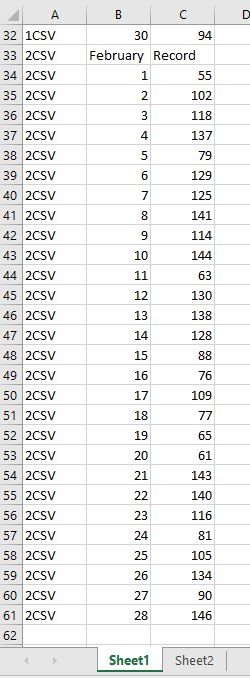如何在Excel中快速批量导入多个csv/文本/xml文件?
在Excel中,您可能尝试过将工作簿另存为csv文件、文本文件或xml文件,但您是否尝试过从文件夹中将多个csv/文本/xml文件导入到一个工作簿或工作表中呢?本文将介绍一些方法来快速批量导入它们。
使用VBA将文件夹中的多个文本文件导入到工作簿的每个工作表中
要从文件夹导入文本文件到工作簿,您可以使用以下VBA代码快速处理它。
1. 打开一个空白工作簿,并按 Alt + F11 键打开 Microsoft Visual Basic for Applications 窗口。
2. 单击 插入 > 模块,并将VBA粘贴到模块窗口中。
VBA:从文件夹导入所有文本文件到工作簿
Sub LoadPipeDelimitedFiles()
'UpdatebyKutoolsforExcel20151214
Dim xStrPath As String
Dim xFileDialog As FileDialog
Dim xFile As String
Dim xCount As Long
On Error GoTo ErrHandler
Set xFileDialog = Application.FileDialog(msoFileDialogFolderPicker)
xFileDialog.AllowMultiSelect = False
xFileDialog.Title = "Select a folder [Kutools for Excel]"
If xFileDialog.Show = -1 Then
xStrPath = xFileDialog.SelectedItems(1)
End If
If xStrPath = "" Then Exit Sub
Application.ScreenUpdating = False
xFile = Dir(xStrPath & "\*.txt")
Do While xFile <> ""
xCount = xCount + 1
Sheets(xCount).Select
With ActiveSheet.QueryTables.Add(Connection:="TEXT;" _
& xStrPath & "\" & xFile, Destination:=Range("A1"))
.Name = "a" & xCount
.FieldNames = True
.RowNumbers = False
.FillAdjacentFormulas = False
.PreserveFormatting = True
.RefreshOnFileOpen = False
.RefreshStyle = xlInsertDeleteCells
.SavePassword = False
.SaveData = True
.AdjustColumnWidth = True
.RefreshPeriod = 0
.TextFilePromptOnRefresh = False
.TextFilePlatform = 437
.TextFileStartRow = 1
.TextFileParseType = xlDelimited
.TextFileTextQualifier = xlTextQualifierDoubleQuote
.TextFileConsecutiveDelimiter = False
.TextFileTabDelimiter = False
.TextFileSemicolonDelimiter = False
.TextFileCommaDelimiter = False
.TextFileSpaceDelimiter = False
.TextFileOtherDelimiter = "|"
.TextFileColumnDataTypes = Array(1, 1, 1)
.TextFileTrailingMinusNumbers = True
.Refresh BackgroundQuery:=False
xFile = Dir
End With
Loop
Application.ScreenUpdating = True
Exit Sub
ErrHandler:
MsgBox "no files txt", , "Kutools for Excel"
End Sub3. 按 F5 键或单击“ 运行”按钮来运行VBA,并在弹出的对话框中选择要从中导入文本文件的文件夹。参见截图:

4. 单击“ 确定”,所选文件夹中的每个文本文件都已导入到当前工作簿的一个工作表中。参见截图:



使用 Kutools AI 解锁 Excel 魔法
- 智能执行:执行单元格操作、分析数据和创建图表——所有这些都由简单命令驱动。
- 自定义公式:生成量身定制的公式,优化您的工作流程。
- VBA 编码:轻松编写和实现 VBA 代码。
- 公式解释:轻松理解复杂公式。
- 文本翻译:打破电子表格中的语言障碍。
使用VBA将文件夹中的多个csv文件导入到单个工作表中
要将文件夹中的所有csv文件导入到单个工作表中,可以使用以下VBA代码。
1. 打开一个空白工作表,并按 Alt + F11 键打开 Microsoft Visual Basic for Applications 窗口。
2. 单击 插入 > 模块,并将以下VBA粘贴到新的 模块窗口中。
VBA:从文件夹导入csv文件到一个工作表中
Sub ImportCSVsWithReference()
'UpdatebyKutoolsforExcel20151214
Dim xSht As Worksheet
Dim xWb As Workbook
Dim xStrPath As String
Dim xFileDialog As FileDialog
Dim xFile As String
On Error GoTo ErrHandler
Set xFileDialog = Application.FileDialog(msoFileDialogFolderPicker)
xFileDialog.AllowMultiSelect = False
xFileDialog.Title = "Select a folder [Kutools for Excel]"
If xFileDialog.Show = -1 Then
xStrPath = xFileDialog.SelectedItems(1)
End If
If xStrPath = "" Then Exit Sub
Set xSht = ThisWorkbook.ActiveSheet
If MsgBox("Clear the existing sheet before importing?", vbYesNo, "Kutools for Excel") = vbYes Then xSht.UsedRange.Clear
Application.ScreenUpdating = False
xFile = Dir(xStrPath & "\" & "*.csv")
Do While xFile <> ""
Set xWb = Workbooks.Open(xStrPath & "\" & xFile)
Columns(1).Insert xlShiftToRight
Columns(1).SpecialCells(xlBlanks).Value = ActiveSheet.Name
ActiveSheet.UsedRange.Copy xSht.Range("A" & Rows.Count).End(xlUp).Offset(1)
xWb.Close False
xFile = Dir
Loop
Application.ScreenUpdating = True
Exit Sub
ErrHandler:
MsgBox "no files csv", , "Kutools for Excel"
End Sub3. 按 F5 键或单击“运行”按钮执行VBA,并弹出一个对话框以选择要从中导入所有csv文件的文件夹。参见截图:

4. 单击“确定”,并弹出一个对话框提醒您是否在导入前清除活动工作表的内容,这里我单击 “是”。参见截图:

单击“是”后,所选文件夹中的所有csv文件都被导入到当前工作表中,并将数据从A列开始向右放置。参见截图:


提示:如果您想将csv文件水平放置在工作表中,可以使用以下VBA代码。
Sub ImportCSVsWithReferenceI()
'UpdatebyKutoolsforExcel20151214
Dim xSht As Worksheet
Dim xWb As Workbook
Dim xStrPath As String
Dim xFileDialog As FileDialog
Dim xFile As String
Dim xCount As Long
On Error GoTo ErrHandler
Set xFileDialog = Application.FileDialog(msoFileDialogFolderPicker)
xFileDialog.AllowMultiSelect = False
xFileDialog.Title = "Select a folder [Kutools for Excel]"
If xFileDialog.Show = -1 Then
xStrPath = xFileDialog.SelectedItems(1)
End If
If xStrPath = "" Then Exit Sub
Set xSht = ThisWorkbook.ActiveSheet
If MsgBox("Clear the existing sheet before importing?", vbYesNo, "Kutools for Excel") = vbYes Then
xSht.UsedRange.Clear
xCount = 1
Else
xCount = xSht.Cells(3, Columns.Count).End(xlToLeft).Column + 1
End If
Application.ScreenUpdating = False
xFile = Dir(xStrPath & "\" & "*.csv")
Do While xFile <> ""
Set xWb = Workbooks.Open(xStrPath & "\" & xFile)
Rows(1).Insert xlShiftDown
Range("A1") = ActiveSheet.Name
ActiveSheet.UsedRange.Copy xSht.Cells(1, xCount)
xWb.Close False
xFile = Dir
xCount = xSht.Cells(3, Columns.Count).End(xlToLeft).Column + 1
Loop
Application.ScreenUpdating = True
Exit Sub
ErrHandler:
MsgBox "no files csv", , "Kutools for Excel"
End Sub 
使用VBA将文件夹中的多个xml文件导入到单个工作表中
如果要将文件夹中的所有XML文件导入到单个工作表中,可以使用以下VBA代码。
1. 选择一个空白工作表以放置导入的数据,并按 Alt + F11 键启用 Microsoft Visual Basic for Applications 窗口。
2. 单击 插入 > 模块,将VBA代码粘贴到模块窗口中。
VBA:从文件夹导入XML文件到工作表中。
Sub From_XML_To_XL()
'UpdatebyKutoolsforExcel20151214
Dim xWb As Workbook
Dim xSWb As Workbook
Dim xStrPath As String
Dim xFileDialog As FileDialog
Dim xFile As String
Dim xCount As Long
On Error GoTo ErrHandler
Set xFileDialog = Application.FileDialog(msoFileDialogFolderPicker)
xFileDialog.AllowMultiSelect = False
xFileDialog.Title = "Select a folder [Kutools for Excel]"
If xFileDialog.Show = -1 Then
xStrPath = xFileDialog.SelectedItems(1)
End If
If xStrPath = "" Then Exit Sub
Application.ScreenUpdating = False
Set xSWb = ThisWorkbook
xCount = 1
xFile = Dir(xStrPath & "\*.xml")
Do While xFile <> ""
Set xWb = Workbooks.OpenXML(xStrPath & "\" & xFile)
xWb.Sheets(1).UsedRange.Copy xSWb.Sheets(1).Cells(xCount, 1)
xWb.Close False
xCount = xSWb.Sheets(1).UsedRange.Rows.Count + 2
xFile = Dir()
Loop
Application.ScreenUpdating = True
xSWb.Save
Exit Sub
ErrHandler:
MsgBox "no files xml", , "Kutools for Excel"
End Sub3. 单击“运行”按钮或按F5键运行VBA,并在弹出的对话框中选择一个文件夹,参见截图:

4. 单击“确定”,所选文件夹中的所有XML文件都被导入到活动工作表中。
使用Kutools for Excel将多个xml/csv文件导入或合并到工作表或工作簿中
如果您不熟悉VBA,不用担心,这里我为您介绍一个实用工具——Kutools for Excel。通过其强大的合并功能,您可以快速将多个xml文件或csv文件合并到一个工作簿或一个Excel工作表中。
安装Kutools for Excel后,请按照以下步骤操作:(立即免费下载Kutools for Excel!)
1. 启动Excel,并单击 Kutools Plus > 合并。参见截图:
2. 在 合并的第一步 对话框中,根据需要选择一个分隔选项。参见截图:
3. 单击 下一步 进入 合并的第二步,单击 添加 以从不同文件夹或一个文件夹中添加文件到 工作簿 列表中,并且您还可以从右侧部分的 工作表 列表中指定要合并的工作表。参见截图:
4. 单击 下一步 进入最后一步 合并,您可以指定合并选项。
5. 单击 完成,弹出一个对话框提醒您选择保存新合并结果的位置。参见截图:
6. 单击 保存。所有添加的工作表都已合并到一个新的单一工作表中。
提示:使用合并功能,您还可以将来自多个文件夹或一个文件夹的多个CSV文件合并到一个工作表或工作簿中。
使用Kutools for Excel将每个工作表导出为csv/文本/pdf到文件夹中
如果您希望将每个工作表导出为csv/文本/pdf文件到文件夹中,Kutools for Excel的分割工作簿功能可以为您提供帮助。
免费下载并安装 Kutools for Excel 后,请按照以下步骤操作:
1. 启用要导出其工作表的工作簿,并单击 Kutools Plus > 工作簿 > 分割工作簿。参见截图:

2. 在 分割工作簿对话框中,您可以勾选需要导出的工作表名称,默认情况下所有工作表都已勾选,并勾选指定保存格式,然后从下拉列表中选择要保存为的文件格式。参见截图:

3. 单击“分割”并在“浏览文件夹”对话框中选择一个文件夹以保存分割后的文件,参见截图:

4. 单击“确定”,现在所有被勾选的工作表都作为新文件格式导出到选定的文件夹中。
相关文章:
最佳Office办公效率工具
| 🤖 | Kutools AI 助手:以智能执行为基础,彻底革新数据分析 |代码生成 |自定义公式创建|数据分析与图表生成 |调用Kutools函数…… |
| 热门功能:查找、选中项的背景色或标记重复项 | 删除空行 | 合并列或单元格且不丢失数据 | 四舍五入…… | |
| 高级LOOKUP:多条件VLookup|多值VLookup|多表查找|模糊查找…… | |
| 高级下拉列表:快速创建下拉列表 |依赖下拉列表 | 多选下拉列表…… | |
| 列管理器: 添加指定数量的列 | 移动列 | 切换隐藏列的可见状态 | 比较区域与列…… | |
| 特色功能:网格聚焦 |设计视图 | 增强编辑栏 | 工作簿及工作表管理器 | 资源库(自动文本) | 日期提取 | 合并数据 | 加密/解密单元格 | 按名单发送电子邮件 | 超级筛选 | 特殊筛选(筛选粗体/倾斜/删除线等)…… | |
| 15大工具集:12项 文本工具(添加文本、删除特定字符等)|50+种 图表 类型(甘特图等)|40+实用 公式(基于生日计算年龄等)|19项 插入工具(插入二维码、从路径插入图片等)|12项 转换工具(小写金额转大写、汇率转换等)|7项 合并与分割工具(高级合并行、分割单元格等)| …… |
通过Kutools for Excel提升您的Excel技能,体验前所未有的高效办公。 Kutools for Excel提供300多项高级功能,助您提升效率并节省时间。 点击此处获取您最需要的功能……
Office Tab为Office带来多标签界面,让您的工作更加轻松
- 支持在Word、Excel、PowerPoint中进行多标签编辑与阅读。
- 在同一个窗口的新标签页中打开和创建多个文档,而不是分多个窗口。
- 可提升50%的工作效率,每天为您减少数百次鼠标点击!
所有Kutools加载项,一键安装
Kutools for Office套件包含Excel、Word、Outlook和PowerPoint的插件,以及Office Tab Pro,非常适合跨Office应用团队使用。
- 全能套装——Excel、Word、Outlook和PowerPoint插件+Office Tab Pro
- 单一安装包、单一授权——数分钟即可完成设置(支持MSI)
- 协同更高效——提升Office应用间的整体工作效率
- 30天全功能试用——无需注册,无需信用卡
- 超高性价比——比单独购买更实惠